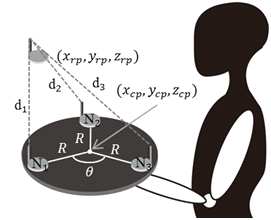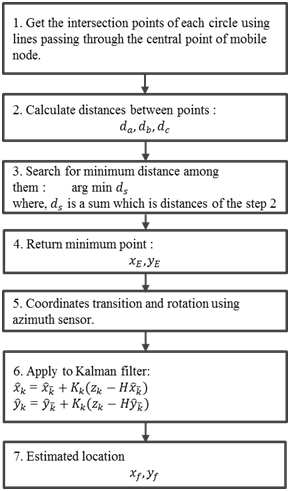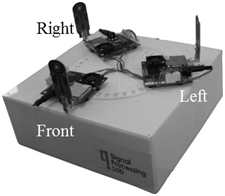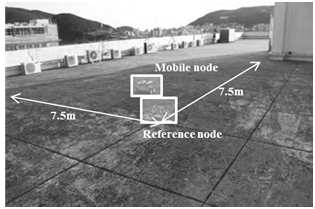
Self-positioning fusion system based on estimation of relative coordinates
Recently, indoor navigation has been applied in large convention centers by using wireless sensor networks (WSNs), which provide not only a user’s path to be traveled but also orientation and shopping information to increase user's convenience. This paper presents the localization system for estimating relative coordinates without pre-deployment of the reference node based on ultra wide band (UWB) ranging system, which is relatively suitable for indoor localization compared to other wireless communications, and azimuth sensor. The proposed localization system which consists of an azimuth sensor and a mobile node composed of three nodes estimates relative coordinates of the reference node without applying any recursive and time consumption algorithms. Also, in the process of estimating relative coordinates of the reference node, ranging errors are minimized through the proposed technique and the number of nodes can be reduced. Experimental results show the feasibility and validity of the proposed system.
Keywords:
Wireless sensor network, Ultra Wide Band, Indoor localization, Relative coordinates, Reference node1. Introduction
Recently, with the rapid development of communication technology, the localization has been applied to various fields such as navigation, logistics, health/medical, military, and entertainment. The global positioning system (GPS) which is used in outdoor localization is often occurred a poor reception in locations of interest such as indoor, forests, and canyons [1]. In the case of these environments, the additional sensors, which are composed of a micro electro mechanical system (MEMS) sensor such as geomagnetic, acceleration, and gyroscope, or an image sensor through the Landmark attached on specific zone are selected for estimating the position based on the reference node. But MEMS sensor is difficult to use alone because of accumulated errors over time and image sensor requires a lot of computation processes because of the amount of image information. Meanwhile, wireless sensor network (WSN) systems estimate the location of the mobile node to use communication module such as Ultra Wide Band (UWB), Zigbee, radio frequency identification (RFID), Wi-Fi, and Ultrasound based on Received Signal Strength Indication (RSSI), time of arrival (ToA), time difference of arrival (TDoA) [2-9]. But it is essential to be installed three or more reference nodes for localization. Therefore, installer should properly deploy reference nodes to receive three or more signals in the special localization region. Accordingly, many researches has actively been studying in the field of deployment of reference nodes and reduction of the number of them. Kim et al. [10] proposed a novel accurate hybrid global self-localization algorithm for determining the posture (or the position and the orientation) of indoor mobile robots. This ultrasonic localization system is composed of several ultrasonic transmitters fixed at reference positions and a 2-D isotropic ultrasonic receiver array mounted on the mobile robots. Experiments results show that the mean of Root Mean Square Metric (RMSM), the mean and variance values of the position and orientation errors, and execution time are more accurate than other existing algorithms. Lin et al. [11] presents methodologies and technologies for ultrasonic localization and pose tracking of an autonomous mobile robot(ARM) by using a fuzzy adaptive extended information filtering scheme. This localization system, which consists of two ultrasonic transmitters and three receivers, is proposed to estimate both the static and the dynamic position and orientation of the ARM. These proposed algorithms are inconvenient that reference nodes should be deployed in an area for estimating the location. Ma et al. [12] proposed improved WLAN indoor positioning system, which successfully enhances the positioning accuracy and cuts down the computational cost simultaneously. The experimental results proved that the positioning accuracy can be increased by 4.56% within 1.5m, and meanwhile, the number of the access points which participate in the process of positioning can be decreased by 33.33%. But localization system based on fingerprint requires a lot of pre-process due to making database for positioning. Seong et al. [13] proposed convergence localization system using RF radio device and pyroelectric sensor. This system can provide reduction of reference node and be applied to solving a problem in the corner section increasing position error due to reflection and refraction of radio wave. The experiment result shows that position accuracy is improved about 86.2% compared to existing method in the ship. But the experiments conducted in the narrow arise are not applied to the wide region such as department store and warehouse. Cho et al. [14] presents estimation algorithm which can reduce the number of fixed nodes by recognizing the relative coordinates of two ones through a mobile node. However, although the experiment results show that the number of fixed nodes can be reduced by up to 50% in the indoor free space, the reference nodes have to be deployed before providing localization service.
In this paper, we present the self-localization system without pre-deployment of reference nodes using azimuth sensor and UWB communication module. The proposed system, which consists of an azimuth sensor and a mobile node composed of three nodes, can reduce the number of reference nodes compared to the existing localization system and provide self-localization system for users who explore or investigate the area where GPS signal is weak or the region where home positioning is required without pre-deployment of reference nodes. Also, in the process of estimating relative coordinates of the reference node, ranging errors are minimized through the proposed technique without applying any recursive and time comsumption algorithms.
2. Related theory
2.1 Existing localization system
RF localization systems using trilateration or angulation technique based on three or more reference nodes are widely used, as shown in Figure 1. Notably, trilateration technique can estimate the distance from the mobile node to the reference node using TOF or RSSI without any supports of hardware. The coordinates of mobile node are obtained by
2.2 SDS-TWR and UWB
SDS-TWR (Symmetric Double Sided Two Way Ranging) technology is a technological extension of time of arrival (TOA) which has two kind of ranging method such as OWR (One-Way Ranging) and TWR (Two-Way Ranging) method using radio propagation delay time between devices. As shown in Figure 2, Device A records the packet transmission starting time while Device B stores the packet arrival time. Device B waits for treplyB followed by transmitting the ranging message to Device A. Here, treplyB is set longer than tpB. Finally, Device B transmits all the measured times to Device A. This round trip time is expressed as
Meanwhile, the UWB technology, which is a part of IEEE 802.15.4a standard, has been used in many localization system since the transmitted signal has an extremely short duration (typically in the order of sub-nanosecond), which can provide ultra high resolution timing information. This technology has high positioning accuracy compared to narrow band communication and good signal reception and transmission in the environment with low signal to noise ratio (SNR).
3. Proposed self-positioning fusion system
Here, we discuss the theoretical background of the proposed localization system. First, a reference node is fixed to the wall with known position (xrp, yrp, zrp). A mobile node which consist of three nodes is placed on the user's hand (xcp, ycp, zcp) as shown in Figure 3. It is assumed that the z-values of the mobile node and the reference node are all the same value (zrp = zcp). The three mobile nodes can be deployed by
where R is the distance from the central of mobile node to each node, and θ=2π(K-1)/3 is the angle of the Kth node deployed. Figure 4 indicates a block diagram of the proposed localization system composed of seven steps including Kalman filtering step. The proposed system provides the location of the mobile node using the azimuth sensor (θg) mounted on it and relative coordinates (xE, yE) of the reference node can be obtained by triangle estimation. Thus, users can estimate his location by himself without pre- deployment of the reference node. In Figure 5(a), the intersection point of circle using received distance (dn, dn2, dn3) from the mobile node to the reference node and the line has a slope of Equation (4) passing through the center point of mobile node.
where θn is a slope of straight line (n=0, 1, 2, ...,179). And then, the distance of the each intersection point is calculated by
where dci is distance between each intersection points, and (xci, yci) and (xcj, ycj) are intersection points. As shown in Figure 5(b), we search for the minimum sum of distances (dc1, dc2, and dc3) between the intersection point obtained from the acquired circles and the straight line. If the minimum sum is obtained up to two or more, the final position of the reference node is estimated by the average of the coordinates according to probability. In the proposed process, the noise from inherent error of the device is reduced using moving average filter given by
where
 and
and
 are k-moving average, and
are k-moving average, and
 and
and
 are newly obtained coordinates. Figure 5(c) shows coordinates transformation based on relative coordinates of reference node by Equation (7) used for obtaining a coordinate of mobile node.
are newly obtained coordinates. Figure 5(c) shows coordinates transformation based on relative coordinates of reference node by Equation (7) used for obtaining a coordinate of mobile node.
where xmt and ymt are the coordinates of mobile node after transformation, and xΔ and yΔ are interval from origin of coordinates to coordinates of estimated reference node. In Figure 5(d), based on the acquired azimuth, we finally determine the coordinates of mobile node after rotation transformation and azimuth θg of sensor acquired by using Equations (8) and (9).

Sequence of proposed system: (a) acquisition of the intersection point, (b) search for the minimum sum of distances, (c) coordinates transformation, (d) determination of coordinates
where xkt, ykt, and zkt are the coordinates of mobile node after rotation and xf, yf, and zf are the final coordinates of the mobile node.
4. Experimental result and analysis
The proposed localization system which is composed of TimeDomain’s P410RCM modules (nodes) and E2BOX’s EBIMU-9DOF (sensor) estimates the location of mobile node and the respective prototype is shown in Figure 6. As shown in Figure 7, experiments are performed by the prototype in the region where LOS(Line of sight) and magnetic field interference are guaranteed. As the radius of the mobile node increased, the distance error of the reference node decreased continuously. The radius of mobile node is set at 14cm considering computer simulation and experiment space. In the general method using P410 RCM module and EBIMU-9DOF module, the maximum, minimum, standard deviation, and average errors of localization are 28.03cm, 7.59cm, 3.11cm, and 14.57cm, respectively. Meanwhile, the respective values of the proposed method are 17.88cm, 1cm, 4.44cm, and 6.45cm, respectively. Also, the localization errors of the special sections which consists of concrete structure are higher than the other ones because those special sections are not guaranteed LOS. Also, in an aspect of deployment of reference nodes, however existing localization systems require the deployment of three or more reference nodes in the space where localization is available, the proposed system can reduce the number of reference nodes according to extension of space of localization given by Equation (10).
where Tor is the number of reference nodes, r is the number of initial reference nodes, and n is over lapping region of communication range for localization.
5. Conclusion and future work
In this paper, we propose the localization system for estimating relative coordinates without pre-deployment of the reference node based on UWB ranging communication devices and azimuth sensor. In spite any recursive algorithms that requires the iterative computation are not applied, the proposed system can reduce the ranging errors and the number of reference nodes compared to the existing localization system and provide self-localization technique in the area where GPS signal is weak or the region where home positioning is required. The experimental results show the feasibility and validity of proposed system. In the future, if the system proposed in this paper is applied for military use, it can be useful for scouting enemy formations where the GPS signal is weak or is being jammed, or when fighting takes place in complicated terrain such as a city full of buildings. In addition, if the proposed system is applied to firefighting or prevention, it can be useful for firefighters to return to a starting point after completion of their mission where vision is obscured due to smoke in warehouses or other large buildings.
Acknowledgments
This paper is extended and updated from the short version that appeared in the Proceedings of the International symposium on Marine Engineering and Technology (ISMT 2013), held at BEXCO, Busan, Korea on October 23-25, 2013.
This work is the outcome of a Manpower Development Program for Marine Energy by the Ministry of Oceans and Fisheries and the National Research Foundation of Korea(NRF) grant funded by the Korea government(MEST) (No. 20110029766).
References
- V. Trifa, L. Girod, T. C. Collier, D. Blumstein, and C. E. Taylor, “Automated wildlife monitoring using self-configuring sensor networks deployed in natural habitats”, Journal of International Symposium on Artificial Life and Robotics, Center for Embedded Network Sensing, (2007).
-
A. Parr, R. Miesen, F. Kirsch, and M. Vossiek, “A novel method for UHF RFID tag tracking based on acceleration data”, Proceedings of the IEEE International Conferenceon RFID, Orlando, Fla, USA, p110-115, (2012).
[https://doi.org/10.1109/RFID.2012.6193037]

-
R. C. Luo, and O. Chen, “Wireless and pyroelectric sensory fusion system for indoor human/robot localization and monitoring”, IEEE/ASME Transactions on mechatronics, 18(3), p845-853, (2013).
[https://doi.org/10.1109/TMECH.2012.2188300]

-
S. Wagner, M. Handte, M. Zuniga, and P. J. Marron, “Enhancing the performance of indoor localization using multiple steady tags”, Pervasive and mobile computing, 9(3), p392-405, (2013).
[https://doi.org/10.1016/j.pmcj.2012.12.002]

-
H. J. Cho, K. I. Hwang, D. S. Noh, and D.H. Seo, “Real time indoor positioning system using IEEE 802.15.4a and sensors”, Journal of the Korean Society of Marine Engineering, 36(6), p850-856, (2012), (in Korean).
[https://doi.org/10.5916/jkosme.2012.36.6.850]

-
J. H. Seong, T. W. Lim, J. S. Kim, S. G. Park, and D. H. Seo, Seo, “An improvement algorithm for localization using adjacent node and distance variation analysis techniques in a ship”, Journal of the Korean Society of Marine Engineering, 37(2), p213-219, (2013), (in Korean).
[https://doi.org/10.5916/jkosme.2013.37.2.213]

-
J. H. Seong, J. S. Park, S. H. Lee, and D.H. Seo, “Indoor localization algorithm based on WLAN using modified database and selective”, Journal of The Korean Society of Marine Engineering, 37(8), p932-938, (2013), (in Korean).
[https://doi.org/10.5916/jkosme.2013.37.8.932]

-
J. H. Kim, H. J. Kim, J. S. Kim, S. G. Lee, and D. H. Seo, “An indoor localization using RSSI and LQI based on IEEE 802.15.4”, Journal of The Korean Society of Marine Engineering, 38(1), p92-98, (2014), (in Korean).
[https://doi.org/10.5916/jkosme.2014.38.1.92]

-
J. H. Kim, H. J. Kim, J. S. Kim, S. G. Lee, and D. H. Seo, “Relative azimuth estimation algorithm using rotational displacement”, Journal of The Korean Society of Marine Engineering, 38(2), p188-194, (2014).
[https://doi.org/10.5916/jkosme.2014.38.2.188]

-
S. J. Kim, and B. K. Kim, “Accurate Hybrid Global Self-Localization Algorithm for indoor mobile robots with two-dimensional isotropic ultrasonic receivers”, IEEE Transactions on Instrumentation and Measurement, 60(10), p3391-3404, (2011).
[https://doi.org/10.1109/TIM.2011.2126890]

- H. H. Lin, C. C. Tsai, and J. C. Hsu, “Ultrasonic localization and pose tracking of an autonomous mobile robot via fuzzy adaptive extended information filtering”, IEEE Transactions on Instrumentation and Measurement, 57(9), p2024-2034, (2008).
- L. Ma, X. Ma, X. Liu, and X. Yubin, “WLAN indoor positioning algorithm based on sub-regions information gain theory”, Proceedings of the IEEE Wireless Communications and Networking Conference, p4789-4794, (2013).
-
J. H. Seong, J. H. Choi, J. S. Kim, and D.H. Seo, “An experimental study on compensation algorithm for localization using modified bilateration technique and pyroelectric sensor in a ship”, Journal of the Korean Society of Marine Environment & Safety, 18(5), p488-495, (2012).
[https://doi.org/10.7837/kosomes.2012.18.5.488]

-
H. J. Cho, J. S. Kim, S. G. Lee, J. W. Kim, and D. H. Seo, “Fixed node reduction technique using relative coordinate estimation algorithm”, Journal of the Korean Society of Marine Engineering, 37(2), p220-226, (2013).
[https://doi.org/10.5916/jkosme.2013.37.2.220]

- H. J. Cho, Y. S. Ha, J. H. Kim, K. S. Rhyu, and D. H. Seo, “Convergence localization system for self-localization based on an estimation of relative coordinates”, Proceedings of the International Symposium on Marine Engineering & Technology 2013, p80-83, (2013).















